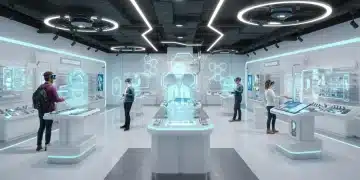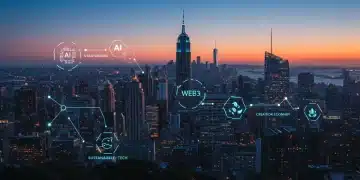Holographic Displays: Commercial Applications Gaining Traction in the US by 2027

Holographic displays are rapidly gaining commercial traction in the US, poised for widespread adoption by 2027, transforming sectors from retail to healthcare with immersive visual experiences and new interactive possibilities.
The vision of interactive, three-dimensional images floating in mid-air is quickly becoming a commercial reality. Holographic Displays: Commercial Applications Gaining Traction in the US by 2027 represents a significant technological leap, moving beyond science fiction to practical implementation across various industries. This emerging trend promises to redefine how businesses engage with consumers and operate internally.
The Dawn of Holographic Retail Experiences
Holographic technology is poised to revolutionize the retail landscape, offering unparalleled immersive experiences that captivate customers and enhance product engagement. Retailers are increasingly exploring these displays to differentiate their brands and create memorable shopping environments.
Early adopters in the US are deploying holographic units for dynamic product showcases, virtual try-ons, and interactive advertising. These installations allow consumers to view products in 3D without physical interaction, providing detailed perspectives and personalized experiences that traditional displays cannot match.
Enhanced Product Visualization
Holographic displays provide a unique advantage by allowing customers to visualize products in a dynamic and interactive 3D format. This goes beyond simple images or videos, creating a sense of presence and tangibility for digital content.
- Interactive Product Demos: Customers can virtually rotate, zoom, and explore product features.
- Virtual Try-Ons: Apparel and accessories can be projected onto a customer’s reflection for an immersive fitting room experience.
- Dynamic Advertising: Eye-catching 3D advertisements draw attention and convey complex messages efficiently.
Major retail chains are currently testing these technologies in flagship stores, gathering valuable data on customer engagement and conversion rates. The feedback indicates a strong positive response, suggesting a broader rollout is imminent.
Healthcare’s Leap into 3D Visualization
The medical sector stands to benefit immensely from the precision and clarity offered by holographic displays. From surgical planning to medical education, the ability to visualize complex anatomical structures in three dimensions is transforming clinical practices and training methodologies.
US hospitals and research institutions are actively integrating holographic systems into their workflows. These displays allow surgeons to review patient scans (MRI, CT) as interactive 3D holograms, providing a more intuitive and comprehensive understanding of complex cases before an incision is even made.
Revolutionizing Surgical Planning
Holographic visualization offers surgeons an unprecedented level of detail and spatial understanding, crucial for intricate procedures. This technology minimizes uncertainties and enhances preparedness, leading to improved patient outcomes.
- Pre-operative Visualization: Surgeons can manipulate 3D models of organs and tumors to plan precise surgical approaches.
- Collaborative Review: Multiple medical professionals can simultaneously view and discuss patient data in a shared holographic space.
- Reduced Errors: Enhanced spatial understanding can significantly lower the risk of complications during surgery.
Medical schools are also adopting holographic technology for educational purposes, providing students with realistic, interactive anatomical models that surpass traditional textbooks and 2D screens. This hands-on approach fosters deeper learning and better preparation for future medical challenges.

Education and Training: Immersive Learning Environments
Beyond healthcare, holographic displays are making significant inroads into general education and corporate training. The technology promises to transform passive learning into active, engaging, and highly effective immersive experiences, particularly in fields requiring complex visualization.
Universities and vocational training centers in the US are experimenting with holographic classrooms and simulation modules. These applications allow students to interact with 3D models of historical artifacts, scientific phenomena, or engineering designs, fostering a deeper understanding that traditional methods often cannot achieve.
Interactive Learning Modules
The interactive nature of holographic content allows for dynamic exploration and manipulation of complex subjects. This direct engagement significantly boosts retention rates and makes learning more enjoyable.
- Scientific Visualization: Students can explore molecular structures, planetary systems, or biological processes in 3D.
- Engineering Design Review: Aspiring engineers can manipulate and analyze holographic prototypes.
- Historical Recreations: Immersive experiences bring historical events and ancient structures to life.
Corporate training programs are also leveraging holography to create realistic simulations for various scenarios, from equipment operation to emergency response drills. This provides a safe and effective environment for skill development without the need for physical prototypes or hazardous conditions.
Advertising and Entertainment: Captivating Audiences
The advertising and entertainment industries are natural fits for holographic displays, given their inherent ability to create visually stunning and attention-grabbing content. Brands and creators are exploring innovative ways to engage audiences with dynamic 3D projections that transcend conventional screens.
From large-scale public installations to personalized interactive kiosks, holographic advertising is emerging as a powerful tool for brand storytelling and product promotion. The novelty and immersive quality of these displays capture consumer attention in an increasingly cluttered media landscape.
Unforgettable Brand Engagements
Holographic advertising offers a unique opportunity to create memorable interactions that resonate with consumers. It moves beyond passive viewing to active engagement, leaving a lasting impression.
- Live Event Enhancements: Concerts and presentations are incorporating holographic elements for spectacular visual effects.
- Interactive Kiosks: Consumers can engage with 3D product information or brand mascots in public spaces.
- Window Displays: Retailers are using holographic projections to create dynamic, eye-catching storefronts that draw in passersby.
In the entertainment sector, holographic technology is being used to bring virtual characters to life, create immersive theatrical experiences, and even project deceased artists for ‘live’ performances. This pushes the boundaries of what is possible in live entertainment and digital content delivery.
Technological Advancements Driving Adoption
The increasing commercial viability of holographic displays is directly linked to significant advancements in underlying technologies. Improved hardware, sophisticated software algorithms, and more accessible manufacturing processes are collectively lowering barriers to entry and expanding application possibilities.
Key progress areas include higher resolution spatial light modulators, more powerful and compact laser systems, and advanced computational algorithms for real-time holographic rendering. These innovations are making holographic projections brighter, clearer, and more stable, even in ambient light conditions.
Key Innovations Fueling Growth
Several technological breakthroughs are converging to accelerate the adoption of holographic display solutions. These advancements address previous limitations, making the technology more practical and cost-effective for commercial use.
- Higher Resolution & Brightness: New display materials and light sources enable clearer, more vibrant holograms.
- Real-time Rendering: Faster processors and optimized algorithms allow for fluid, interactive 3D content.
- Miniaturization & Portability: Smaller form factors are opening up possibilities for mobile and integrated applications.
- Cost Reduction: Manufacturing efficiencies are gradually making holographic displays more affordable for businesses.
Furthermore, the integration of artificial intelligence and machine learning is enhancing holographic interactivity, enabling more natural user interfaces and adaptive content delivery. This allows for personalized experiences and more intuitive control over holographic projections.
Challenges and Future Outlook for US Market
Despite rapid advancements, the widespread adoption of holographic displays in the US still faces certain challenges, primarily related to cost, content creation, and user experience. Addressing these hurdles will be crucial for the technology to fully realize its potential by 2027 and beyond.
The cost of high-fidelity holographic systems remains a significant investment for many businesses, limiting initial deployment to well-funded enterprises or niche applications. Additionally, creating compelling 3D holographic content requires specialized skills and software, which can be a barrier for smaller organizations.
Overcoming Adoption Barriers
Industry leaders are actively working to mitigate these challenges through various strategies, including developing more user-friendly content creation tools and scaling production to drive down hardware costs.
- Content Development Tools: Simplification of SDKs and platforms for easier 3D content creation.
- Standardization: Efforts to establish industry standards for holographic content and hardware interoperability.
- User Interface Refinement: Improving gesture controls and natural language processing for intuitive interaction.
- Infrastructure Development: Ensuring sufficient bandwidth and processing power for seamless holographic experiences.
Looking ahead to 2027, analysts predict a significant acceleration in market penetration as these challenges are addressed. The US market is expected to lead in commercial applications due to its strong innovation ecosystem and high consumer demand for cutting-edge technologies. Partnerships between tech companies and industry players are also driving tailored solutions for specific sectors.
| Key Application Area | Brief Impact Description |
|---|---|
| Retail & Advertising | Enhances customer engagement through interactive 3D product showcases and dynamic advertising. |
| Healthcare | Revolutionizes surgical planning and medical education with precise 3D anatomical visualization. |
| Education & Training | Creates immersive learning environments, improving comprehension and retention through interactive 3D models. |
| Entertainment | Offers captivating visual effects for live events and new forms of interactive storytelling. |
Frequently Asked Questions About Holographic Displays
Holographic displays project three-dimensional images that appear to float in space, visible from multiple angles without special glasses. They work by manipulating light waves to recreate the entire light field of an object, providing depth and realism.
Currently, retail, advertising, healthcare, and education are at the forefront of adopting holographic displays. These sectors benefit from enhanced visualization, immersive customer engagement, and advanced training capabilities offered by the technology.
Advances in spatial light modulators, laser systems, real-time rendering algorithms, and miniaturization are crucial. These innovations improve image quality, reduce size, and lower costs, making holographic displays more commercially viable for various applications.
Significant challenges include the high initial cost of advanced systems, the complexity and expense of creating specialized 3D holographic content, and the ongoing need for user interface refinement to ensure intuitive interaction across diverse applications.
Analysts and industry experts predict that holographic displays will achieve significant commercial traction in the US market by 2027. This timeline is supported by accelerated technological development and increasing investment in commercial applications.
Looking Ahead: The Immersive Future
The rapid evolution of Holographic Displays: Commercial Applications Gaining Traction in the US by 2027 signals a profound shift in how we interact with digital information and physical spaces. As the technology matures and costs decrease, expect to see holographic integrations become increasingly commonplace in everyday environments. Businesses that embrace this immersive future early will be well-positioned to lead their respective markets. The ongoing research into more natural human-computer interaction with holograms, coupled with advancements in AI-driven content generation, suggests an even more seamless and personalized holographic experience in the very near future. Watch for continued partnerships and pilot programs across industries, driving innovative uses for this groundbreaking technology.





